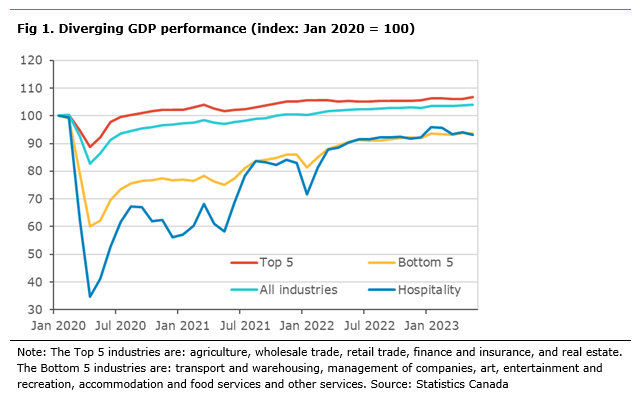Economic insight provided by Alberta Central Chief Economist Charles St-Arnaud.
Bottom line
Today’s release of the monthly GDP suggests that the momentum in the Canadian economy is slowing after a strong start to 2023. As such, while economic activity was robust in May, the preliminary estimate for June suggests activity decreased 0.2% m-o-m. However, many temporary factors are affecting the Canadian economy: a drop in oil and gas production due to the forest fires in Alberta, the return to work in the public sector following the April strike, and a normalization of the supply chain boosting the manufacturing and wholesale sectors. In addition, the strike at Vancouver Port is likely to temporarily hold back activity in July.
All those temporary factors are blurring somewhat the underlying strength of the economy. As such, many sectors linked to consumer discretionary spending, namely retail trade, arts, entertainment and recreation, and real estate, remained robust. Household spending remains surprisingly resilient, likely supported by the strong labour market, and key to the outlook. Nevertheless, the economic momentum is slowing.
The Bank of Canada will welcome the slower momentum, as it remained concerned that excess demand is not resorbing as fast as they hoped. As a result, we believe that the policy rate likely peaked in July and that the central bank will remain on hold until mid-2024.
For Alberta, the details available in the report suggest that economic activity likely contracted significantly in May due to the drop in activity in the oil and gas sector due to the forest fires and its impact on related sectors. The situation is expected to be temporary with some production restarting in July. High energy prices have been a tailwind to the Alberta economy this year, but not as much as in the past (see Where’s the boom? How the impact of oil on Alberta may have permanently weakened). However, the continued strong population growth in the province continues to push economic activity higher.
The monthly GDP rose 0.3% m-o-m in May (+1.9% y-o-y). The details show that 12 out of 20 industrial sectors posted gains on the month. Despite the overall economy being 3.5 percentage points above its pre-pandemic level, 7 out of 20 industrial sectors still have economic activity below their pre-pandemic levels, namely utilities, transportation and warehousing, management of companies, administration and support services, arts, entertainment and recreation, and accommodation and food services. In the case of natural resource extraction, the decline in activity below its pre-pandemic level is the result of production stoppages in the oil and gas sector due to wildfires in May in Alberta and should prove temporary.
Statistics Canada’s preliminary estimate suggests GDP for June declined by 0.2% m-o-m. This suggests that growth in the second quarter of 2023 should be around 1.0% q-o-q ar.
The goods-producing side of the economy decreased by 0.3% m-o-m in May. Economic activity in natural resource extractions dropped by 2.9% m-o-m, because of a sharp reduction in oil and gas extraction due to the forest fires in Alberta. Construction (-0.8% m-o-m) and agriculture (-1.1% m-o-m) also declined on the month. A sharp increase in manufacturing (+1.6% m-o-m) and utilities (+0.1% m-o-m) partly offset those declines.
The services-producing side of the economy rose 0.5% in May. The increase in activity was mainly driven by wholesale trade (+2.9% m-o-m), public sector (+1.4% m-o-m), and real estate (0.5% m-o-m). The sharp rise in public administration was due to a normalization in activity after the strike in April. Declines in transportation and warehousing (+0.2%), mainly due to lower oil and gas pipeline activity linked to weaker production, and accommodation and food services (-1.1% m-o-m) were the main drag to growth in the sector.
For Alberta, there is no specific data in the report. However, we can make an assessment based on activity in some key industries specific to Alberta. The level of activity in the oil and gas and pipeline sectors dropped sharply on the month, because of the forest fires in the province. A decline in agriculture, the eight consecutive decline, may also have acted as a drag on growth. Overall, this means that the province’s economy likely underperformed significantly the rest of the country in May.



Independent Opinion
The views and opinions expressed in this publication are solely and independently those of the author and do not necessarily reflect the views and opinions of any organization or person in any way affiliated with the author including, without limitation, any current or past employers of the author. While reasonable effort was taken to ensure the information and analysis in this publication is accurate, it has been prepared solely for general informational purposes. There are no warranties or representations being provided with respect to the accuracy and completeness of the content in this publication. Nothing in this publication should be construed as providing professional advice on the matters discussed. The author does not assume any liability arising from any form of reliance on this publication.